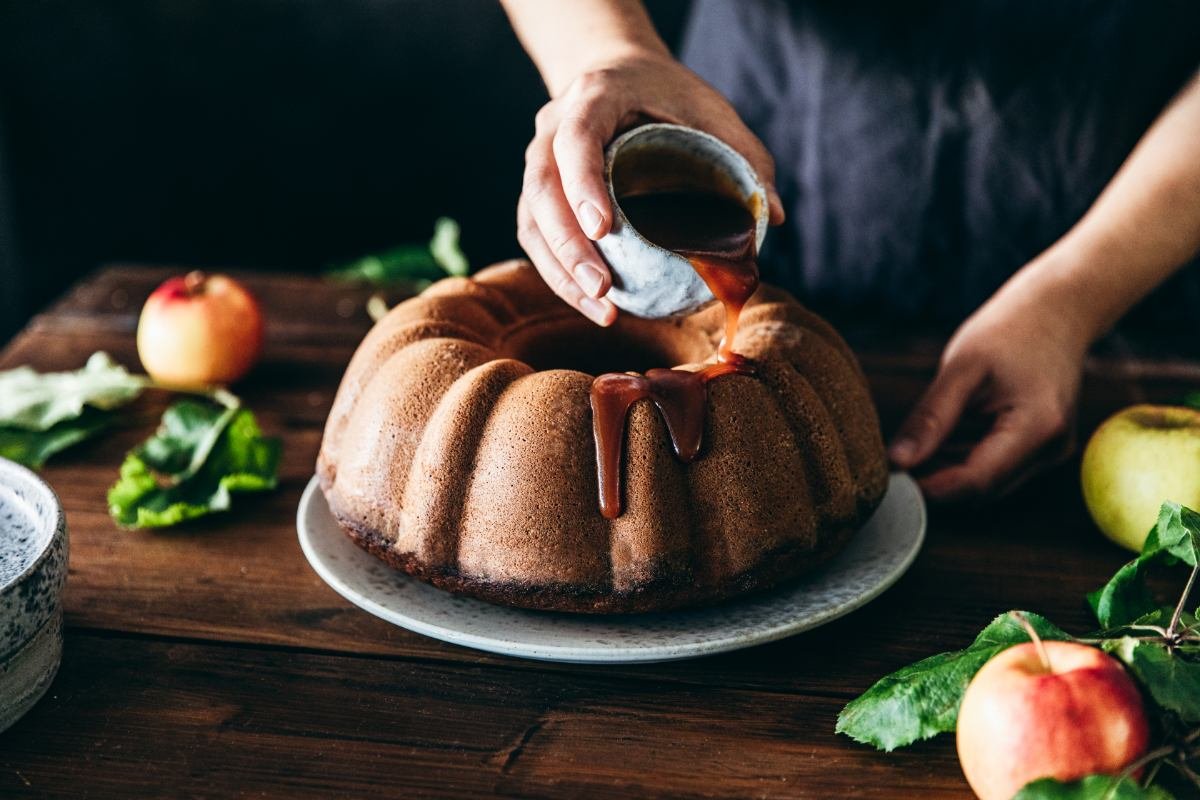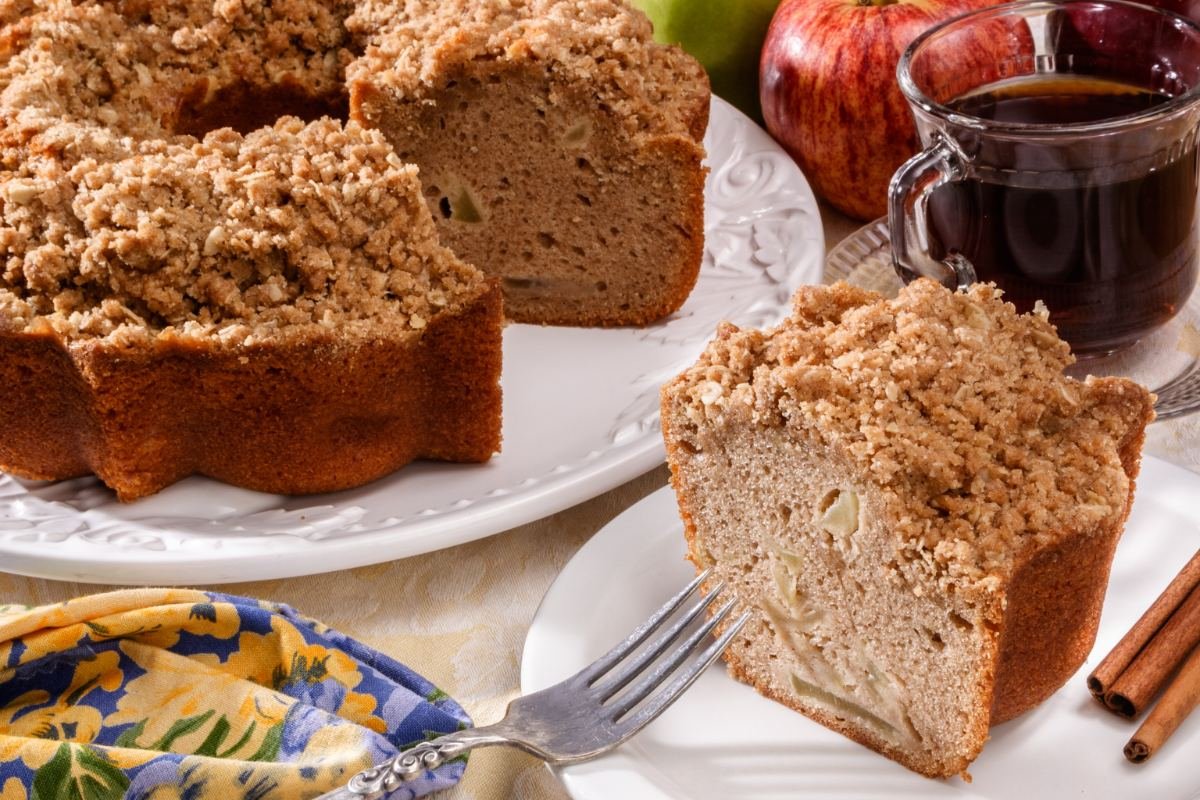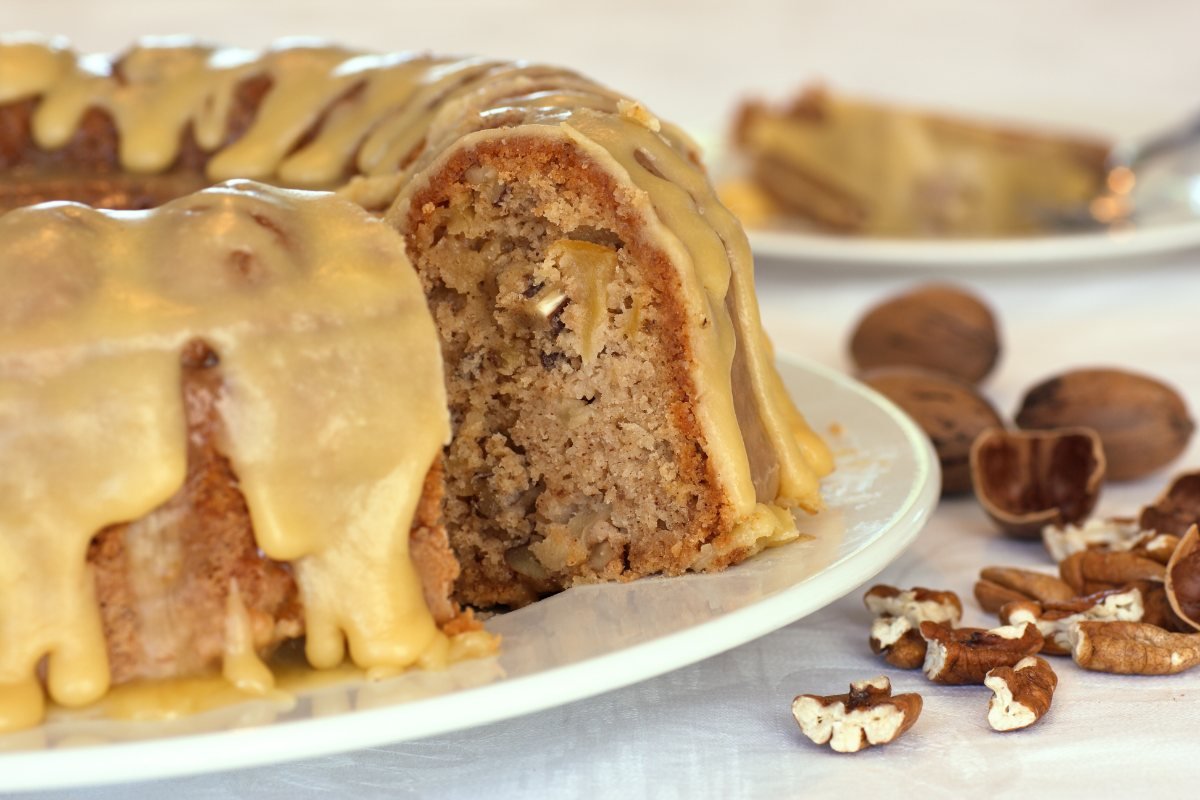Introduction
Pound cake, a beloved classic with a history as rich as its flavor, has been gracing tables for centuries. Originating from Europe in the early 1700s, the cake was named for its simple, yet precise recipe that called for a pound each of flour, sugar, butter, and eggs. This traditional dessert has evolved over the years, adopting various flavors and ingredients, yet its comforting essence remains unchanged. Among the myriad of variations, the butter pecan pound cake stands out as a particularly sumptuous treat. This blog post delves into the delightful world of butter pecan pound cake, exploring its ingredients, preparation, and the unique charm it brings to any gathering.
Combining the nutty richness of pecans with the creamy sweetness of butter, this cake variant introduces a textural symphony that is both indulgent and elegant. The key to its irresistible flavor lies in the high-quality ingredients and the careful balance of sweetness and nuttiness. Whether you’re a seasoned baker or a novice eager to try your hand at a classic dessert with a twist, this guide will walk you through everything you need to know about making a perfect butter pecan pound cake.
The Ingredients
Crafting a butter pecan pound cake that’s both flavorful and textured to perfection starts with selecting the right ingredients. Let’s dive into each component, understanding its role and exploring how quality and substitutions can influence the final product.
Flour: The Foundation
- Role: Flour provides structure to the cake, forming the base that supports all other ingredients. It’s essential for creating the desired density and texture characteristic of a pound cake.
- Choosing Quality: Opt for all-purpose flour for its reliable results. For an even finer crumb, some bakers prefer cake flour due to its lower protein content, which makes for a tender cake.
- Substitutions: For a gluten-free version, a 1:1 gluten-free baking flour mix can replace all-purpose flour without sacrificing texture.
Sugar: Sweetness and Moisture
- Role: Sugar is not just a sweetener; it’s crucial for the cake’s moisture and texture. It also aids in browning and contributes to the crust’s crispy edge.
- Choosing Quality: Granulated white sugar is standard, but using a portion of light brown sugar can enhance the pecan flavor with its molasses notes.
- Substitutions: Those monitoring sugar intake can consider alternatives like coconut sugar, but adjustments to quantity may be necessary due to varying sweetness levels.
Butter: Richness and Flavor
- Role: The namesake ingredient, butter, infuses the cake with richness and depth. It’s key for that melt-in-your-mouth texture and pairs beautifully with the pecan’s nuttiness.
- Choosing Quality: Use unsalted, high-quality butter for better control over the cake’s saltiness and to ensure a pure, creamy flavor.
- Substitutions: For dairy-free diets, vegan butter substitutes can work, though they may slightly alter the texture and flavor profile.
Eggs: Structure and Leavening
- Role: Eggs bind the ingredients together, provide moisture, and help the cake rise. They’re integral to achieving the pound cake’s signature density and height.
- Choosing Quality: Fresh, room temperature eggs are best for a smooth batter and optimal volume.
- Substitutions: Egg replacers or flaxseed meal mixed with water can be used for those avoiding eggs, keeping in mind the possible impact on texture.
Pecans: The Signature Crunch
- Role: Pecans not only impart a distinctive, nutty flavor but also introduce a delightful crunch, contrasting the cake’s tender crumb.
- Choosing Quality: Toasting the pecans before adding them to the batter or as a topping enhances their flavor and crunchiness.
- Substitutions: While pecans are central to this cake, walnuts can be used as a substitute if pecans are unavailable or if a different nutty note is desired.
Baking Powder & Soda: The Lift
- Role: These leavening agents are crucial for a light, airy structure, ensuring the cake rises properly without becoming too dense.
- Choosing Quality: Make sure your baking powder and soda are fresh for maximum effectiveness.
- Substitutions: If you’re out of baking powder, a mix of cream of tartar and baking soda can serve as a homemade alternative.
Vanilla Extract and Salt: Flavor Enhancers
- Role: Vanilla extract adds depth and warmth, complementing the butter and pecans, while salt balances sweetness and brings out all the flavors.
- Choosing Quality: Pure vanilla extract offers a more complex flavor profile than imitation versions. For salt, fine sea salt dissolves easily and offers a clean taste.
- Substitutions: Almond extract can substitute for vanilla for a different flavor twist. Kosher salt is a good alternative to sea salt, but adjust the quantity as needed due to differing grain sizes.
Choosing the right ingredients and making informed substitutions can transform a good butter pecan pound cake into a great one. Each component plays a crucial role in the cake’s texture, flavor, and overall delight. Armed with these insights, you’re well on your way to baking a masterpiece.
Step-by-Step Recipe

Creating a butter pecan pound cake that impresses both in taste and appearance is an art. This section guides you through the process, ensuring each step is clear and manageable. Let’s bake a cake that’s as delightful to look at as it is to eat.
Preparing Your Ingredients and Equipment
- Gather Ingredients: Start by measuring all your ingredients accurately. This ensures a smooth baking process and a consistent outcome.
- Toast the Pecans: Preheat your oven to 350°F (175°C). Spread the pecan halves on a baking sheet and toast for about 10 minutes until they’re fragrant and slightly darker. Let them cool, then chop coarsely.
- Prepare Your Pan: Grease and flour a 10-inch bundt pan thoroughly to prevent sticking. Don’t forget the crevices where the cake is most likely to stick.
- Prep Your Workstation: Lay out all the tools you’ll need, including mixing bowls, a mixer (stand or handheld), and measuring cups and spoons.
Mixing the Batter
- Cream Butter and Sugar: In a large mixing bowl, beat the unsalted butter and sugar at medium speed until light and fluffy. This step is crucial for creating a fine crumb.
- Add Eggs: Incorporate the eggs one at a time, beating well after each addition. Ensure each egg is fully integrated before adding the next to achieve a smooth batter.
- Combine Dry Ingredients: In a separate bowl, whisk together the flour, baking powder, and salt. Sifting these ingredients helps prevent lumps and ensures a finer cake texture.
- Blend in the Dry Ingredients: Gradually add the dry ingredients to the butter mixture, alternating with the milk. Start and end with the flour mixture. Mix just until combined to avoid overworking the batter.
- Fold in the Pecans and Vanilla: With a spatula, gently fold in the toasted pecans and vanilla extract, distributing them evenly throughout the batter.
Baking the Cake
- Fill the Pan: Pour the batter into the prepared bundt pan, smoothing the top with a spatula.
- Bake: Bake in the preheated oven for about 60-70 minutes. The cake is done when a toothpick or cake tester inserted into the center comes out clean.
- Cooling: Allow the cake to cool in the pan on a wire rack for about 20 minutes. Then, invert the cake onto the rack to cool completely. Patience is key; removing the cake too soon could cause it to break.
The Icing on the Cake
- Prepare the Glaze: While the cake cools, prepare your butter pecan glaze (details in the next section). Drizzle the glaze over the cooled cake, letting it drip down the sides for a visually appealing finish.
- Garnish: Sprinkle some extra toasted pecans on top for added crunch and presentation.
Serving
- Serve and Enjoy: Slice the cake into even portions and serve. This cake pairs wonderfully with coffee or tea, making it a perfect dessert or afternoon treat.
This detailed guide is designed to take the mystery out of making a butter pecan pound cake. By following these steps, you’re on your way to baking a cake that’s as beautiful as it is delicious. The right techniques, coupled with attention to detail, can turn a simple recipe into a standout dessert that’s sure to impress.
The Icing on the Cake: Butter Pecan Glaze
A butter pecan pound cake wouldn’t be complete without its crowning glory: a rich, nutty glaze that adds an extra layer of flavor and elegance. This section walks you through creating a butter pecan glaze that’s both simple and irresistibly delicious.
Ingredients for the Glaze
Before you start, gather the following ingredients:
- Butter: The base of your glaze, adding richness and flavor.
- Brown Sugar: Adds a deep, caramel-like sweetness that complements the pecans perfectly.
- Heavy Cream: Gives the glaze a luxurious texture and smoothness.
- Vanilla Extract: Enhances the overall flavor of the glaze.
- Chopped Toasted Pecans: For that signature butter pecan taste and added texture.
Preparing the Glaze
- Melt the Butter: In a small saucepan over medium heat, melt the butter.
- Add Brown Sugar: Once the butter is melted, stir in the brown sugar. Cook, stirring constantly, until the sugar has completely dissolved and the mixture is bubbling.
- Mix in Heavy Cream: Slowly pour in the heavy cream, continuing to stir. Allow the mixture to come to a light boil; then reduce the heat and let it simmer for a few minutes until it thickens slightly.
- Remove from Heat: Take the saucepan off the heat. Stir in the vanilla extract and the toasted chopped pecans, mixing well to ensure the pecans are evenly distributed throughout the glaze.
- Let it Cool: Allow the glaze to cool for a few minutes. It should be warm and pourable, not hot and runny, for the perfect consistency to coat the cake.
Glazing the Cake
- Check the Cake’s Temperature: Ensure the cake has cooled completely before you start glazing. A warm cake might absorb the glaze too quickly, affecting the texture.
- Drizzle Over the Cake: Spoon the glaze over the top of the cake, letting it drip down the sides. Use a spatula or the back of a spoon to spread it evenly, covering the surface.
- Let it Set: Allow the glaze to set for about 30 minutes before serving. This gives it time to firm up slightly, making it easier to slice the cake without the glaze running.
Final Touches
- Garnish: For an extra touch of elegance, sprinkle a few more toasted pecans over the glazed cake.
- Serving: Slice the cake into generous portions and serve. The glaze, with its rich flavor and smooth texture, complements the dense, nutty cake beautifully.
Creating this butter pecan glaze is about enhancing the cake’s flavors while adding a visually appealing finish. It’s a simple process that yields a delectable topping, elevating the humble pound cake into a dessert worthy of any special occasion.
Serving Suggestions

Presenting your butter pecan pound cake beautifully is just as important as its taste. This section offers tips on slicing, serving, and pairing your cake, making it a hit for any occasion.
Cutting the Perfect Slice
- Use the Right Knife: A serrated knife works best for cutting through the cake without crushing it. Ensure the knife is sharp for clean, precise slices.
- Cool Completely: Before slicing, ensure the cake and glaze have cooled and set completely. This patience pays off with neat slices that showcase the cake’s texture.
- Warm the Knife: For even cleaner cuts, run your knife under hot water and dry it before each slice. This trick melts through the glaze smoothly, leaving sharp, defined edges.
Presentation
- Plating: Serve each slice on individual plates for a touch of elegance. Choose plates that contrast the color of the cake to make it stand out.
- Garnishing: A sprig of mint or a dusting of powdered sugar can add a visually appealing touch without overpowering the cake’s flavors.
Pairing with Beverages
- Coffee: A classic pairing, the rich flavor of coffee complements the nutty, buttery notes of the cake, making it ideal for a brunch or after-dinner treat.
- Tea: For those who prefer tea, choose a bold, black tea or a nutty, roasted green tea. These can stand up to the cake’s richness while providing a refreshing contrast.
- Dessert Wines: A sweet, fortified wine like port or a late-harvest Riesling can balance the cake’s sweetness with acidity, enhancing its flavors.
How to Store Leftovers
- Airtight Container: Keep any leftover cake in an airtight container to prevent it from drying out. It can be stored at room temperature for up to three days or refrigerated for up to a week.
- Serving After Storage: If refrigerated, let the cake come to room temperature before serving to ensure the best flavor and texture. A quick microwave blitz for 10-15 seconds can also revive the buttery richness if needed.
Creative Serving Ideas
- A La Mode: Elevate your serving by accompanying a slice of cake with a scoop of vanilla or butter pecan ice cream. The contrast of warm cake with cold ice cream is delightful.
- With Fruit: A side of fresh berries or a drizzle of fruit compote can add a tart contrast to the cake’s sweetness, making for a balanced and refreshing dessert.
Presenting and serving your butter pecan pound cake with care not only enhances the eating experience but also turns your dessert into a memorable centerpiece for any gathering. From the moment it’s placed on the table to the last delicious bite, these tips ensure your cake is enjoyed to its fullest.
Nutritional Information and Dietary Modifications
While indulging in a slice of butter pecan pound cake is a delightful treat, being mindful of its nutritional content and understanding how to adapt it to various dietary needs can make this dessert accessible to more people. This section provides a basic nutritional overview and suggests modifications for those with dietary restrictions.
Nutritional Overview
- Calories: A typical slice of butter pecan pound cake is rich in calories due to its high content of butter, sugar, and nuts. It’s a treat best enjoyed in moderation.
- Fats: The cake is high in fats, particularly saturated fats from butter and pecans. These contribute to the cake’s moist, dense texture.
- Sugars: With both granulated and brown sugar, the cake is high in sugars, providing its sweet flavor profile.
- Protein: Eggs and nuts offer some protein, though the cake is not a significant source of this macronutrient.
Remember, the actual nutritional values can vary based on the specific recipe and portion size.
Gluten-Free Modification
For those avoiding gluten, replace all-purpose flour with a gluten-free flour blend. Look for a blend designed for baking, which typically includes xanthan gum to help mimic the texture of gluten-containing cakes.
Dairy-Free Modification
Replace butter with a dairy-free alternative, such as vegan butter or coconut oil. For the glaze and batter, substitute heavy cream with coconut cream or a nut-based milk, adjusting the amount to achieve the desired consistency.
Reducing Sugar
To lower the sugar content, consider reducing the amount of granulated sugar in the batter by up to one-third. Be mindful that this may slightly alter the cake’s texture and moistness. For a sugar substitute, try using a granulated sugar alternative that measures like sugar, but remember to check if it’s suitable for baking.
Adding Fiber
Incorporate a small amount of whole wheat flour in place of some all-purpose flour to increase the cake’s fiber content. You can also add ground flaxseed to the batter for additional fiber and omega-3 fatty acids without significantly altering the flavor.
Nutritional Adjustments for Health
Making these adjustments can help cater to various dietary needs, allowing more people to enjoy this delicious dessert. It’s important to experiment with substitutions to find the right balance that maintains the cake’s texture and flavor while accommodating dietary restrictions.
The Cultural Significance of Pound Cake
Pound cake, with its simple ingredients and rich history, holds a cherished spot in many cultures, especially within American cuisine. The evolution of this classic dessert, including the beloved butter pecan variant, reflects changing tastes, regional influences, and the enduring appeal of comfort food.
Origins and Evolution
- European Roots: Originating in Europe in the 1700s, the original pound cake recipe was straightforward—equal parts butter, sugar, flour, and eggs. Its simplicity made it popular, and it has endured through the centuries, adapting and evolving.
- American Adaptation: As the recipe crossed the Atlantic, American bakers embraced and modified it, incorporating local ingredients and preferences. This adaptability has led to the creation of countless variations, including the butter pecan pound cake.
Regional Variations
- Southern Tradition: In the American South, pound cake holds a place of honor, reflecting the region’s fondness for rich, indulgent desserts. The addition of pecans, a Southern staple, to pound cake is a testament to the region’s culinary creativity and resourcefulness.
- Global Flavors: Around the world, variations of the pound cake incorporate local flavors and ingredients, from citrus and almond to chocolate and spices, showcasing the cake’s versatility and universal appeal.
Celebrations and Traditions
- Family Gatherings: Pound cake is a common feature at family reunions, holiday celebrations, and special occasions, symbolizing warmth, hospitality, and tradition.
- Community Events: Often shared at potlucks, church picnics, and community gatherings, pound cake fosters a sense of community and connection, serving as a reminder of shared histories and values.
The Art of Baking
- Skill and Patience: Crafting a perfect pound cake, especially one as nuanced as the butter pecan variant, requires skill, patience, and attention to detail. The process of baking and sharing these cakes is a labor of love, passed down through generations.
- Creative Expression: The endless variations of pound cake represent the creativity and personal touch of bakers everywhere. Each recipe tells a story, reflecting the tastes, traditions, and ingenuity of its creator.
Pound cake’s enduring popularity is a testament to its timeless appeal and the capacity for simple ingredients to create something truly special. The butter pecan pound cake, with its rich flavors and textures, is a celebration of this tradition, inviting us to savor a piece of culinary history with every bite.
FAQs
Can I use margarine instead of butter in the recipe?
While butter is recommended for its flavor and texture, you can use margarine as a substitute. However, be aware that this may slightly alter the taste and richness of the cake.
How do I prevent my pound cake from being too dry?
To avoid a dry pound cake, ensure you’re measuring your ingredients accurately, especially the flour. Overbaking is another common culprit, so keep an eye on your cake and perform a toothpick test to ensure it’s perfectly done.
Can this cake be made in advance?
Yes, this butter pecan pound cake can be made in advance. It actually tastes better the next day as the flavors meld together. Store it in an airtight container at room temperature for up to 3 days or refrigerate for up to a week.
Is it necessary to toast the pecans?
Toasting the pecans is not strictly necessary, but it’s highly recommended. Toasting enhances their flavor and adds an extra layer of crunchiness to the cake, elevating the overall taste.
How can I make the cake more moist?
Adding a bit more dairy, such as sour cream or yogurt, can enhance the cake’s moisture. Be cautious with adjustments to ensure the batter maintains the correct consistency.
Can I freeze butter pecan pound cake?
Absolutely! Wrap the cake well in plastic wrap and then in foil. It can be frozen for up to 3 months. Thaw overnight at room temperature before serving.
What can I use if I don’t have a bundt pan?
If you don’t have a bundt pan, you can use a loaf pan or two. Adjust the baking time accordingly, as it may vary based on the size and material of your pan.
Conclusion
As we’ve journeyed through the delightful world of butter pecan pound cake, from its rich ingredients and meticulous preparation to its cultural resonance and adaptable variations, it’s clear that this dessert is more than just a treat. It’s a testament to the joy of baking, the warmth of sharing, and the beauty of culinary tradition. Whether you’re a seasoned baker or new to the kitchen, the butter pecan pound cake offers a delicious opportunity to create, enjoy, and share a piece of culinary art.
For more delicious recipes and baking inspiration, be sure to visit RecipesZap, where you’ll find a treasure trove of ideas to spark your next kitchen adventure.
And if you’re interested in exploring the broader context of pound cake in the tapestry of global desserts, Epicurious offers a fascinating look at its evolution and the myriad ways bakers around the world have made it their own.
Happy baking, and may your kitchen always be filled with the sweet aroma of butter, pecans, and joy.

